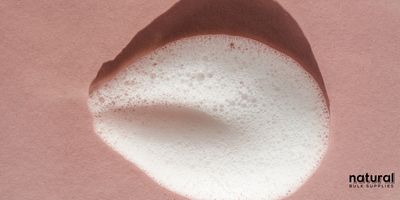Glucoside Surfactants & Types: Comprehensive Guide
Posted by Natural Bulk Supplies on on Apr 17th 2022
Alkyl Polyglucosides (AGPs) or Glucosides are a new generation of commercially available, biodegradable surfactants. They produce stable foam to enhance the texture and cleansing properties of cosmetics and personal care products.
Usually derived from sugars, such as glucose derivatives and fatty alcohols, Alkyl Polyglucosides have gained a stellar reputation as high-performance components for cosmetic preparations. Their organic and eco-friendly nature is another reason why formulators turn to AGPs when creating all-natural vegan cosmetic products.
Some other pleasing attributes of glucosides include:
●Mild surfactants: Glucosides are mild and gentle surfactants that lower the surface tension of products they’re added to, helping them remove dirt and oils more effectively from the skin and hair.
●High-foaming properties: Glucosides were first used in soaps and body cleansers because of their incredible foaming power. They lather easily and thicken while retaining skin moisture, even when used daily.
●Derived from natural sources: Glucosides are obtained from 100% renewable raw materials through a combination of plant-based alcohol and glucose, making them completely natural and safe for everyday use.
●Superior wetting properties: As a surfactant, Glucosides also improve your aqueous formulation’s ability to spread across different surfaces and lather foam that’s stable and long-lasting.
●Compatible with other surfactants: Due to their mild nature, Glucosides work incredibly well as co-surfactants. By reducing the total active requirements of other active ingredients, they offer cleansing effectiveness, foam volume, and ease of thickening without altering the performance of the final product.
What Are Surfactants?
Surfactants or surface-active agents lower the surface tension between liquids, gases, and solids. In cosmetics, surfactants are used for cleansing, foaming, thickening, emulsifying, solubilizing, and other special effects.
There are various types of surfactants: anionic surfactants, nonionic surfactants, cationic surfactants, and amphoteric surfactants. Among these, nonionic surfactants are considered to be the safest and most effective ingredient for skin and hair care products. This is because nonionic surfactants are neutral, gentle, and are very good at emulsifying oils - a valuable property that allows oil and water to mix in various kinds of formulations.
How Are Glucoside Surfactants Made?
Alkyl Polyglucoside is a nonionic surfactant, prepared by the glycosylation of starch or monomer glucose with fatty alcohols. The optimum surface activity is obtained with an alkyl chain of C8 to C16.
If you want to create safe formulations for soaps, shampoos, body washes, creams, lotions, or other personal care items, Alkyl Polyglucosides is your safest bet.
Types Of Glucosides
You can make many kinds of Alkyl Glucosides by combining different ingredients with the carbon chain alcohol and cyclic glucose. The most popularly used glucosides in the cosmetic industry include:
●Decyl glucoside
●Coco glucoside
●Lauryl glucoside
●Capryl glucoside
You may remember these names from shampoo labels or body wash products, but how does one type of Alkyl Polyglucoside differ from the other?
At first, they all look the same: a light or pale yellowish liquid with a DP (degree of polymerization) value of 1.3-1.5 and 50% solid content. However, the main difference between these glucosides is their viscosity and foaming abilities.
1.Decyl Glucoside
Decyl glucoside is a versatile, plant-based surfactant that is produced from coconuts and cornstarch. The carbon chain length used to make Decyl glucoside is 60% C8-C10 and 40% C12-C14. By reacting decyl alcohol with cyclic glucose, this substance is drawn out of sugars and fatty acids by a process known as esterification.
With a viscosity level of 1000-2500 (mPa•s, 20℃), Decyl glucoside produces the fastest, wealthiest foam, but the foam also disappears quickly as compared to other Glucosides. Its low viscosity also enhances the fluidity of your formulation.
Decyl glucoside is a great addition to products that require rich and dense foams, such as:
●Shampoos
●Conditioners
●Shower gels
●Bath oils
●Dermatological liquid soaps
●Hair colors
●Hair straightening products
Apart from its excellent foaming abilities, Decyl glucoside helps skin and hair retain moisture and keeps them healthy. It also works very well with Cocamidopropyl betaine, which is an amphoteric surfactant with antistatic properties for hair care formulations.
According to the Cosmetics Ingredient Review, Decyl glucoside is safe for use in almost all topical applications or products, specifically in soaps, bubble baths, body washes, and detergents.
Regardless of what kind of product you want to try, Decyl glucoside has a good safety profile for all skin types and is 100% biodegradable - the perfect congenial ingredient to add to your creations if you are concerned about health, wellness, and the environment.
2.Coco Glucoside
When glucose reacts chemically with the fatty alcohols derived from Coconut oil, Coco glucoside: a natural, gentle, and environmentally friendly surfactant is formed. Coco glucoside has a carbon chain length of 40% C8-C10 and 60% C12-C14. With a viscosity of 2500-6000 (mPa•s, 20℃), Coco-Glucoside holds the middle ground between the foam stability of Decyl glucoside and Lauryl glucoside.
Sourced from coconut oil, this soothing, raw material has non-greasy, hydrating, and conditioning properties. When added to skin and hair products, these properties help prevent the skin from drying out and smooth out the hair strands. Since it is compatible with all other surfactants, you can mix it as a co-surfactant without risking the stability, or the foaming and cleansing capacity of the end product.
With its ultra-gentle cleansing properties, Coco glucoside is well-suited for all skin types and is the perfect addition to mild, natural formulations that are specially intended for sensitive skin.
Coco Glucoside is most commonly used in:
●Shampoos
●Conditioners
●Body washes
●Cleansers
●Hand soaps
●Body scrubs
●Acne treatments
●Facial moisturizers
●Hair dyes
●Baby products
3.Lauryl Glucoside
Lauryl glucoside is another non-ionic surfactant that is used as a foaming agent, viscosity builder, conditioner, and emulsifier. It is formed by a carbon chain length of C12-C14 with a viscosity level of 2000-4000 (mPa•s, 40℃). Since it comes from coconut or palm oil, it is biodegradable.
As a mild surfactant and cleansing agent, Lauryl glucoside breaks the surface tension, allowing dirt and oil to be removed easily. This is one of the many reasons why formulators add Lauryl glucoside to baby cleansing products.
When compared to Coco glucoside and Decyl glucoside, Lauryl glucoside takes more time to foam. But it also creates the most stable foam.
Several agencies such as Safe Cosmetics Database, Google guide database, EcoCert, and Organic Food Federation consider Lauryl glucoside to be a completely safe and natural ingredient that poses little or no risk of irritation.
However, on rare occasions, some people may be allergic to glucosides and may develop irritation after using products containing Lauryl glucoside. Therefore, it is recommended to always do a patch test before using products with lauryl glucoside.
Lauryl Glucoside is most commonly used in:
●Sunscreens
●Baby cleansing products
●Facial foams
●Cleansers
●Gels
●Hair cleansing products
4.Capryl Glucoside
Capryl glucoside is a highly effective natural and biodegradable surfactant that’s produced by the reaction of glucoside with capric alcohol. This glucose alkyl ether is made from a carbon chain length of C8-C10 and contains 60% active matter. It is ECOCERT certified and preservative-free.
Capryl glucoside is a clear to light yellow viscous liquid, which increases the foaming capacity and creates a fine and stable foam in skincare and haircare products.
In addition to being an excellent, gentle cleansing surfactant, Capryl glucoside is also a good solubilizer and emulsifier, allowing essential oils and water to mix. Due to this dual-purpose, capryl glucoside is one of the easiest ingredients to work with and creates many types of formulations such as:
●Shower gels
●Shampoos
●Liquid hand soaps
●Creams
●Face washes
Conclusion
When you consider making your own cosmetic products, it is important to select natural and wholesome ingredients whenever possible. You want to make sure that your products are naturally moisturizing and nourishing your skin and hair rather than drying it out or causing irritation. By incorporating natural glucosides into your personal care products, you not only ensure your own safety but the safety of the environment with safe and eco-friendly formulas.
If you are thinking about ordering some of our glucosides or other natural ingredients and want to know more about how they are sourced, you can reach us at www.naturalbulksupplies.com/

